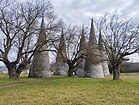Vukovar | |
|---|---|
| Grad Vukovar City of Vukovar | |
|
Clockwise, from top:Eltz Manor; Vukovar water tower; Dudik Memorial Park; View of Vukovar city; Franciscan monastery with church of Saints Philip and James and Workers' Hall | |
| Nickname: Grad Heroj (Hero City) | |
 Location of Vukovar Municipality | |
 | |
| Coordinates: 45°20′40″N 19°00′09″E / 45.34444°N 19.00250°E | |
| Country | |
| Region | Podunavlje |
| County | |
| Government | |
| • Mayor | Ivan Penava (DP) |
| • City Council | 19 members |
| Area | |
• City | 100.1 km2 (38.6 sq mi) |
| • Urban | 61.6 km2 (23.8 sq mi) |
| Elevation | 108 m (354 ft) |
| Population (2021)[2] | |
• City | 23,175 |
| • Density | 230/km2 (600/sq mi) |
| • Urban | 22,255 |
| • Urban density | 360/km2 (940/sq mi) |
| Demonym(s) | Vukovarac (masculine) Vukovarka (feminine) |
| Time zone | UTC+1 (CET) |
| • Summer (DST) | UTC+2 (CEST) |
| Postal code | 32 000 |
| Area code | 032 |
| Vehicle registration | VU |
| Website | vukovar |
The Vučedol Dove, ritual vessel made between 2800 and 2500 BCE, a historical symbol of Vukovar.
Vukovar (pronounced [ʋûkoʋaːr]; Serbian Cyrillic: Вуковар, Hungarian: Vukovár, German: Wukowar) is a city in Croatia, in the eastern regions of Syrmia and Slavonia. It contains Croatia's largest river port, located at the confluence of the Vuka and the Danube. Vukovar is the seat of Vukovar-Syrmia County and the second largest city in the county after Vinkovci. The city's registered population was 22,616 in the 2021 census, with a total of 23,536 in the municipality.[3]
- ^ Register of spatial units of the State Geodetic Administration of the Republic of Croatia. Wikidata Q119585703.
- ^ "Population by Age and Sex, by Settlements" (xlsx). Census of Population, Households and Dwellings in 2021. Zagreb: Croatian Bureau of Statistics. 2022.
- ^ "Population by Age and Sex, by Settlements, 2011 Census: Vukovar". Census of Population, Households and Dwellings 2011. Zagreb: Croatian Bureau of Statistics. December 2012.











